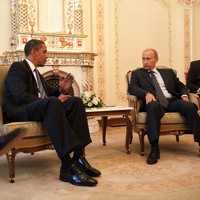The past year has witnessed a high-profile disagreement between Moscow and Washington over the civil war in Syria and the broader direction of political change in the Arab world. Some Russians have even revealed a degree of schadenfreude over the latest anti-U.S. violence in Libya, where Russian President Vladimir Putin likened last year’s NATO intervention to a medieval crusade. But though Washington and Moscow differ on rhetoric and tactics, when it comes to core U.S. interests in the Middle East, such as managing the rise of political Islam, constraining Iran’s nuclear program and ensuring the welfare of the state of Israel, there is more convergence than disagreement between the former Cold War rivals.
Finger-wagging aside, Russia’s main message during the so-called Arab Spring has not been about the United States. Rather, it has been about the Middle Eastern societies undergoing intense political change. And herein lies perhaps the biggest fundamental difference between Washington and Moscow in the “new” Middle East: whether the changes sweeping the region should be eagerly supported or warily monitored. Moscow’s experience as a patron of various regional strongmen and militant groups during the Cold War and afterward has taught Russian policymakers to approach political transitions with extreme caution, all the more so when they involve nationalist or Islamist ideologies and heavily armed private militias. From its own history, too, Russia has reason to trust the maxim that revolutions devour their children and are not especially kind to meddling foreigners.
Unlike the Soviet Union, and in contrast to activist U.S. foreign policy over the past decade, Putin’s Russia is a “status quo” power. Influential Russians profit handsomely from the global economy’s seemingly limitless appetite for raw materials, which Russia exports in every direction, including to growing markets throughout the Muslim world. While it is true that oil and gas prices would rise as a result of instability in the Middle East, Russia has more to lose than to gain from the prospect of prolonged interruptions in trade through the region’s critical crossroads, which could sink an already fragile recovery for the global economy.

